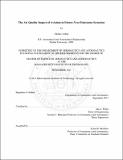| dc.contributor.advisor | Ian A. Waitz. | en_US |
| dc.contributor.author | Ashok, Akshay | en_US |
| dc.contributor.other | Massachusetts Institute of Technology. Dept. of Aeronautics and Astronautics. | en_US |
| dc.date.accessioned | 2012-01-11T20:16:41Z | |
| dc.date.available | 2012-01-11T20:16:41Z | |
| dc.date.copyright | 2011 | en_US |
| dc.date.issued | 2011 | en_US |
| dc.identifier.uri | http://hdl.handle.net/1721.1/68168 | |
| dc.description | Thesis (S.M.)--Massachusetts Institute of Technology, Dept. of Aeronautics and Astronautics, 2011. | en_US |
| dc.description | This electronic version was submitted by the student author. The certified thesis is available in the Institute Archives and Special Collections. | en_US |
| dc.description | Cataloged from student submitted PDF version of thesis. | en_US |
| dc.description | Includes bibliographical references (p. 104-112). | en_US |
| dc.description.abstract | The rapid growth of aviation is critical to the world and US economy, and it faces several important challenges among which lie the environmental impacts of aviation on noise, climate and air quality. The first objective of this thesis addresses the requirements of section 753 of the US Energy Policy Act, and entails the quantification of present and future-year regional air quality impacts of US Landing and Take-Off (LTO) aviation emissions. In addition, this thesis characterizes the sensitivity of these impacts to variations in the projection of non-aviation anthropogenic emissions (referred to as background emissions). Finally, the implication of a future-year background emissions scenario on the current policy analysis tool, the response surface model (RSMv2), is discussed. Aviation emissions for 2006 are generated using the Aviation Environmental Design Tool (AEDT), while future-year aviation emissions are developed for 2020 and 2030 using the Federal Aviation Administration (FAA) Terminal Area Forecast (TAF) and the International Civil Aviation Organization (ICAO) Committee on Aviation Environmental Protection (CAEP/8) NOx Stringency scenario #6. Background emissions for the year 2005 and 2025 are generated from the US Environmental Protection Agency (EPA) National Emissions Inventory (NEI), and two additional sensitivity scenarios are derived from the emissions forecasts. Uncertainties in present and forecast aviation and background emissions are also characterized. The Community Multiscale Air Quality (CMAQ) model is evaluated to quantify its performance in predicting ambient PM2.5 and ozone concentrations, and it is used to estimate aviation air quality impacts of aviation. Future-year aviation particulate matter (PM2.5) concentrations are found to increase by a factor of 2 and 2.4 by 2020 and 2030, and are dominated by nitrate and ammonium PM. Aviation 8-hour daily maximum ozone is seen to grow by a factor of 1.9 and 2.2 by 2020 and 2030, with non-homogeneous spatial impacts. Aviation PM2.5 varies by +/-25% with a +/-50% variation of the forecast change in background emissions, while changes in ozone impacts are less symmetric at +34%/-21%. The RSMv2 is shown to under-predict future-year aviation nitrate and ammonium PM2.5. Finally, the implications of these results on the aviation industry and on aviation policy are discussed. | en_US |
| dc.description.statementofresponsibility | by Akshay Ashok. | en_US |
| dc.format.extent | 128 p. | en_US |
| dc.language.iso | eng | en_US |
| dc.publisher | Massachusetts Institute of Technology | en_US |
| dc.rights | M.I.T. theses are protected by
copyright. They may be viewed from this source for any purpose, but
reproduction or distribution in any format is prohibited without written
permission. See provided URL for inquiries about permission. | en_US |
| dc.rights.uri | http://dspace.mit.edu/handle/1721.1/7582 | en_US |
| dc.subject | Aeronautics and Astronautics. | en_US |
| dc.title | The air quality impact of aviation in future-year emissions scenarios | en_US |
| dc.type | Thesis | en_US |
| dc.description.degree | S.M. | en_US |
| dc.contributor.department | Massachusetts Institute of Technology. Department of Aeronautics and Astronautics | |
| dc.identifier.oclc | 768429481 | en_US |
